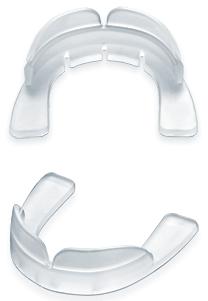 When you experience sensitive teeth, the first consideration should be to determine the cause of the pain since it may be difficult to differentiate between sensitive teeth or dentin hypersensitivity and a variety of other tooth pains and discomforts. Dentin or pulpal pain (caused by a noxious agent, i.e. dental caries) can be intensified by thermal change, sweet, and sour, all of which could elicit a hypersensitivity reaction as well. A differential diagnosis to rule out other conditions must be established before resorting to treatment. Diagnostic aids include history of pain, percussion and palpation tests, inspection of the teeth and surrounding tissues, thermal and electric pulp tests, and radiographic examination. Once other causes for tooth pain have been ruled out, and dentin hypersensitivity has become the established diagnosis, an individualized management strategy with suitable treatment recommendations should be developed to address your specific needs.
When you experience sensitive teeth, the first consideration should be to determine the cause of the pain since it may be difficult to differentiate between sensitive teeth or dentin hypersensitivity and a variety of other tooth pains and discomforts. Dentin or pulpal pain (caused by a noxious agent, i.e. dental caries) can be intensified by thermal change, sweet, and sour, all of which could elicit a hypersensitivity reaction as well. A differential diagnosis to rule out other conditions must be established before resorting to treatment. Diagnostic aids include history of pain, percussion and palpation tests, inspection of the teeth and surrounding tissues, thermal and electric pulp tests, and radiographic examination. Once other causes for tooth pain have been ruled out, and dentin hypersensitivity has become the established diagnosis, an individualized management strategy with suitable treatment recommendations should be developed to address your specific needs.
There are numerous treatment strategies and interventions to manage tooth sensitivity. In addition to pain control, long-term management is most successful when treatment strategies include the elimination or reduction of contributing factors. Sensitive teeth are best managed through self-care, professional care, or a combination of the two. Exposed dentin surfaces that do not elicit pain need only be monitored and treated as needed to reduce tooth decay risk.
What are the different treatment strategies and interventions for sensitive teeth?
Self-care strategies
A thorough assessment and evaluation of your current oral hygiene practices, parafunctional and dietary habits are necessary prior to recommending strategies to follow as the simple alteration of these alone can positively impact the treatment and prevention of sensitive teeth.
-
Tooth brushing
– Type of toothbrush
A soft toothbrush with rounded bristles lowers the risk of gingival recession and abrasion of cementum and exposed dentin. If you are using power toothbrush, you should grasp the toothbrush lightly and apply minimal pressure.
-Brushing technique and sequence
The brushing sequence is best started in a non-sensitive areas and ended with the most sensitive area. Brushing strokes that are focused on one to two teeth should be used instead of long horizontal strokes reaching across several teeth.
-Use of non-dominant hand
Use of the non-dominant hand by an aggressive brusher forces attention to the tooth brushing task and increases awareness of the need to reduce the amount of pressure applied.
-Change grasp
It takes a conscious effort to change from using a palm grasp. By increasing the awareness of brushing technique, you can focus on brushing thoroughly but gently.
-
Dentifrice
-Fluoride
Use of a standard fluoridated dentifrice can cause abrasive particles to be deposited at dentin tubule openings and encourage their closure. Some individuals experience greater tooth sensitivity as a result of using tartar control dentifrices, possibly due to the pyrophosphate content. Its use should be limited to prevent further abrasion and sensitivity.
-Desensitizing dentifrice
 This is appropriate for mild to moderate hypersensitivity. Currently, the active agent in commercial desensitizing dentifrices is 5% potassium nitrate in gel or paste. The action of potassium nitrate (5%) is thought to penetrate through the dentinal tubules towards the pulp, depolarizing the nerve and preventing repolarization, thereby blocking pain transmission. Several desensitizing dentifrices contain both potassium nitrate alone or with fluoride which promotes tooth remineralization. The abrasive agent in a desensitizing dentifrice can occlude dentinal tubules and remain resistant to removal. Desensitizing dentifrices generally require two to four weeks before sensitivity is reduced and discontinuation frequently results in a return of the sensitivity. Continued use is recommended to maintain desensitization benefits.
This is appropriate for mild to moderate hypersensitivity. Currently, the active agent in commercial desensitizing dentifrices is 5% potassium nitrate in gel or paste. The action of potassium nitrate (5%) is thought to penetrate through the dentinal tubules towards the pulp, depolarizing the nerve and preventing repolarization, thereby blocking pain transmission. Several desensitizing dentifrices contain both potassium nitrate alone or with fluoride which promotes tooth remineralization. The abrasive agent in a desensitizing dentifrice can occlude dentinal tubules and remain resistant to removal. Desensitizing dentifrices generally require two to four weeks before sensitivity is reduced and discontinuation frequently results in a return of the sensitivity. Continued use is recommended to maintain desensitization benefits.
-
Mouth rinses
Some mouth rinses have an acidic pH and can dissolve the smear layer. Consequently, use of these products could present a risk factor for sensitive teeth, particularly for those with gingival recession and loss of tooth structure. It has been suggested that mouthwash use followed by brushing would enhance dissolution of the smear layer, exposing dentin tubules. On the other hand, mouth rinses have been suggested as a vehicle for applying a desensitizing agent. A reduction in sensitivity has been demonstrated using a combined sequential rinse of chlorhexidine (0.12%) followed by a rinse. Additionally, a 3% potassium nitrate/0.2% sodium fluoride mouth rinse appears to have a therapeutic effectiveness in alleviating sensitive teeth.
-
Dietary Modifications
The consumption of acidic foods and drinks, such as citrus fruits and juices, and carbonated beverages should be controlled, since they can contribute to erosion of the enamel or cementum and expose underlying dentin. Brushing immediately after ingesting acidic foods should also be avoided as it may accelerate the combined effects of abrasion and erosion. Additionally, acidic food and drink dissolve the smear layer in a few minutes. In managing hypersensitivity, brushing before eating acid containing or generating foods is recommended, although this is counter to recommendations for caries prevention. Additional recommendations can include sipping acidic beverages through a straw, reducing the quantity and frequency of acid intake, drinking something neutral or alkaline—such as milk or water—after consuming dietary acids, and avoiding foods that have sharp flavors, spices, or are extremely hot or cold. An approach as simple as making dietary changes could provide pain relief. Extreme dentin loss from combined erosion and abrasion as seen in purging and acid reflux has been demonstrated. This possibility of eating disorders should not be overlooked. Appropriate treatment and referral is essential.
-
Reduce or eliminate para-functional habits
 Para-functional habits, such as teeth clenching and grinding, may be a factor in eccentric occlusal loading that leads to tooth flexure potentially resulting in an abfraction lesion that may contribute to sensitive teeth as the tubules become exposed. Initiating stress reduction methods can reduce these behaviors. Professionally fabricated occlusal night guards can also reduce the effects of unconscious habits such as these.
Para-functional habits, such as teeth clenching and grinding, may be a factor in eccentric occlusal loading that leads to tooth flexure potentially resulting in an abfraction lesion that may contribute to sensitive teeth as the tubules become exposed. Initiating stress reduction methods can reduce these behaviors. Professionally fabricated occlusal night guards can also reduce the effects of unconscious habits such as these.
What if all these fail?
Sensitivity that is not responsive to self-care strategies should be reevaluated for professional management which includes topical application of desensitizing agents, tooth restorations to seal and occlude dentin tubules, periodontal surgery to cover sensitive areas and lasers used in conjunction with fluoride varnishes.